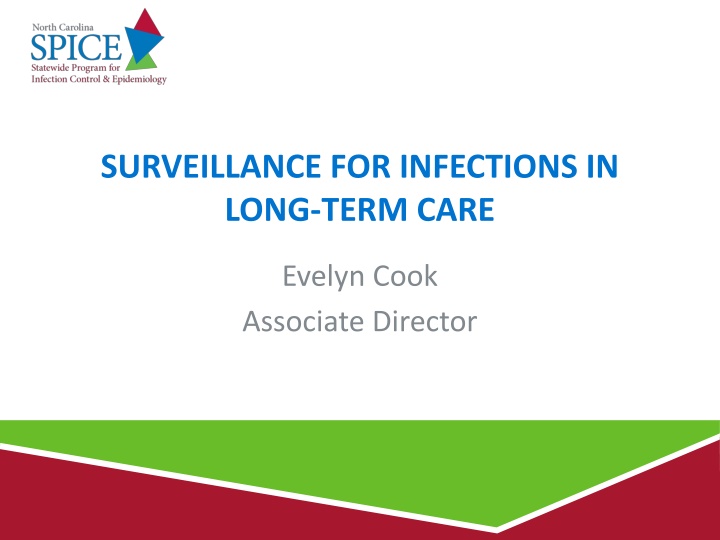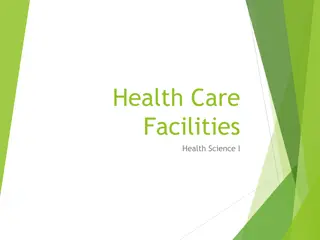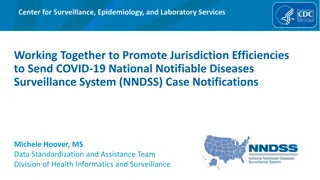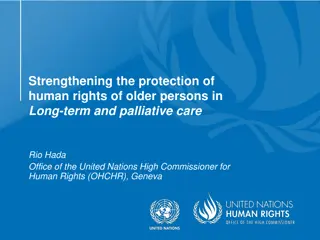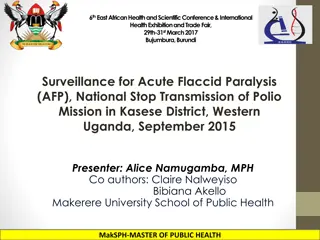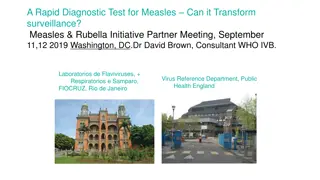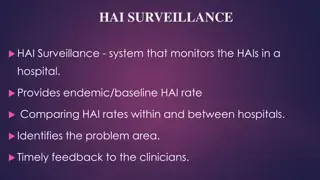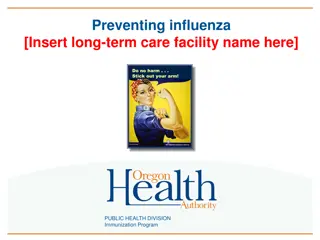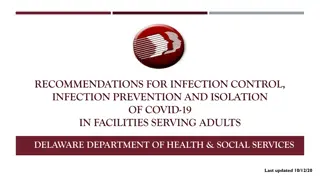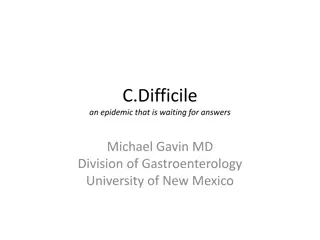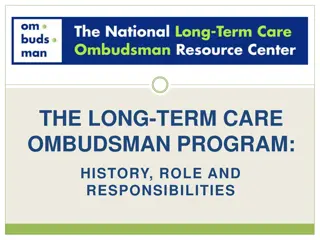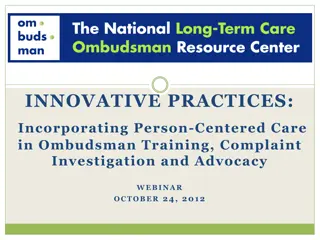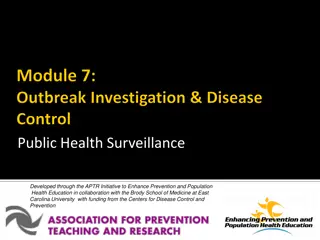Enhancing Infection Surveillance in Long-Term Care Facilities
Explore the importance of surveillance, new definitions, implementation strategies, and outcomes in long-term care settings. Understand why surveillance is essential, how it is performed, population assessment, various surveillance approaches, and selection criteria for processes and outcomes.
Download Presentation

Please find below an Image/Link to download the presentation.
The content on the website is provided AS IS for your information and personal use only. It may not be sold, licensed, or shared on other websites without obtaining consent from the author.If you encounter any issues during the download, it is possible that the publisher has removed the file from their server.
You are allowed to download the files provided on this website for personal or commercial use, subject to the condition that they are used lawfully. All files are the property of their respective owners.
The content on the website is provided AS IS for your information and personal use only. It may not be sold, licensed, or shared on other websites without obtaining consent from the author.
E N D
Presentation Transcript
SURVEILLANCE FOR INFECTIONS IN LONG-TERM CARE Evelyn Cook Associate Director
Objectives Discuss the importance of surveillance Describe the new surveillance definitions Discuss ways to implement and apply new surveillance definitions
Definition contd Surveillance is a comprehensive method of measuring outcomes and related processes of care, analyzing the data, and providing information to members of the healthcare team to assist in improving those outcomes and processes 2015
Why do Surveillance? Reduce infection rates Establish baseline data Detection of outbreaks Monitor effectiveness of preventative and infection control interventions Education of personnel Required as a component of your IP program
Assess the Population What is the geographic location of the long-term care facility? What types of residents are served? What are the most common diagnoses? What are the most frequently performed invasive procedures? Which services or treatments are utilized most frequently? What types of residents are at greatest risk of infection? Are there any health concerns emerging from the community?
Approaches to Surveillance Facility-wide (Total) surveillance Targeted (Focused) surveillance Combination of both (total surveillance for MRSA and focused for UTI in one area)
Selection of Processes and Outcomes Processes Hand hygiene Urinary Catheter insertion/maintenance Outcomes Acute respiratory infections Urinary tract infections Skin/Soft Tissue Infections Gastroenteritis
Consideration for choosing Outcomes Mandatory/required Frequency (incidence) of the infection Communicability System/resident cost ( mortality, hospitalization) Early Detection Outcomes selected for surveillance should be re-evaluated annually as a component of the IP risk assessment
Infections that should be included in routine surveillance Points to Consider Infections Comments Evidence of transmissibility in a healthcare setting Viral respiratory tract infections, viral GE, and viral conjunctivitis Associated with outbreaks among residents and HCP in LTCFs Processes available to prevent acquisition of infection Clinically significant cause of morbidity or mortality Pneumonia, UTI, GI tract infections, (including C. difficile) and SSTI Associated with hospitalization and functional decline in LTCF residents Specific pathogens causing serious outbreaks Any invasive group A Streptococcus infection, acute viral hepatitis, norovirus, scabies, influenza A single laboratory- confirmed case should prompt further investigation
Infections that could be included in routine surveillance Points to Consider Infections Comments Infections with limited transmissibility in a healthcare settings Ear and sinus infections, fungal oral and skin infections and herpetic skin infections Associated with underlying comorbid conditions and reactivation of endogenous infection Infections with limited preventability
Infections for which other accepted definitions should be applied in LTCF surveillance Points to Consider Infections Comments Infections with other accepted definitions (may apply to only specific at-risk residents) Surgical site infections, central-line- associated bloodstream infections and ventilator-associated pneumonia LTCF-specific definitions were not developed. Refer to the National Healthcare Safety Network s criteria
Sources of Data for Surveillance Clinical ward/unit rounds Medical Chart Lab reports Kardex/Patient Profile/Temperature logs Antibiotic Starts
IMPLEMENTING AND APPLYING SURVEILLANCE DEFINITIONS
Guiding Principles for LTCF Criteria Infection surveillance only Applied retrospectively as it relates to clinical diagnosis/treatment Focus on transmissible/preventable infections Not for case finding Not for diagnostic purposes Not for clinical decision making
Attribution of infection to LTCF No evidence of an incubating infection at the time of admission to the facility Basis of clinical documentation of appropriate signs and symptoms and not solely on screening microbiologic data Onset of clinical manifestation occurs > 2 calendar days after admission.
Attribution of infection to LTCF All symptoms must be new or acutely worse Non-infectious causes of signs and symptoms should always be considered prior to diagnosis Identification of an infection should not be based on a single piece of evidence Clinical, microbiologic, radiologic Diagnosis by physician insufficient (based on definition)
Constitutional Requirements Fever: A single oral temperature >37.8 C [100 F], OR Repeated oral temperatures >37.2 C [99 F]; rectal temperature >37.5 (99.5 F) OR >1.1 C [2 F] over baseline from a temperature taken at any site No time frame provided??
Constitutional Requirements Leukocytosis Neutrophilia > 14000 WBC/mm3 OR Left shift (>6% bands or 1500 bands/mm3)
Constitutional Requirements Acute Change in Mental Status from Baseline Based on Confusion Assessment Method (CAM) criteria available in MDS Change Criteria Acute Onset Evidence of acute change in mental status from resident baseline Fluctuating Behavior fluctuating (e.g., coming and going or changing in severity during assessment) Inattention Resident has difficulty focusing attention (e.g., unable to keep track of discussion or easily distracted Disorganized Thinking Resident s thinking is incoherent (e.g., rambling conversation, unclear flow of ideas) Either /or Altered level of consciousness Resident s level of consciousness is described as different from baseline (e.g., hyperalert, sleepy, drowsy, difficult arouse, nonresponsive)
Constitutional Requirements Acute Functional Decline New 3 point increase in total ADL score (0-28) from baseline based on 7 ADLs {0 = independent; 4 = total dependence} 1. Bed mobility 2. Transfer 3. Locomotion within LTCF 4. Dressing 5. Toilet use 6. Personal hygiene 7. Eating
Question Which statement(s) meet constitutional requirements? 1. The resident must have a temperature >101 F 2. The resident doesn t seem to be herself today 3. The resident hasn t been ambulatory for 3 months 4. The resident has a WBC count 15000 WBC/mm3
Respiratory Tract Infections Criteria Comments A. Common cold syndrome/pharyngitis Fever may or may not be present. Symptoms must be new, and not attributable to allergies At least two criteria present 1. Runny nose or sneezing 2. Stuffy nose (i.e., congestion) 3. Sore throat or hoarseness or difficulty swallowing 4. Dry cough 5. Swollen or tender glands in neck
Respiratory Tract Infections Criteria Comments B. Influenza-like Illness If criteria for influenza-like illness and another upper or lower respiratory tract infection are met at the same time, only the diagnosis of influenza-like illness should be used Both criteria 1 and 2 present 1. Fever 2. At least three of the following symptom sub-criteria (a-f) present a. Chills Due to increasing uncertainty surrounding the timing of the start of influenza season, the peak of influenza activity and the length of the season, seasonality is no longer part of the criteria to define influenza-like illness b. New headache or eye pain c. Myalgias or body aches d. Malaise or loss of appetite e. Sore throat f. New or increased dry cough
Respiratory Tract Infections Criteria Comments C. Pneumonia All criteria 1-3 present For both pneumonia and lower respiratory tract infections, presence of underlying conditions which could mimic a respiratory tract infection presentation (congestive heart failure, interstitial lung disease), should be excluded by review of clinical records and an assessment of presenting symptoms and signs 1. Interpretation of chest radiograph as demonstrating pneumonia or the presence of new infiltrate 2. At least one of the following respiratory sub- criteria (a-f) present a. New or increased cough b. New or increased sputum production c. O2 saturation <94% on room air or a reduction in O2 saturation of more than 3% from baseline d. New or changed lung exam abnormalities e. Pleuritic chest pain f. Respiratory rate of 25/min 3. At least one constitutional criteria
Respiratory Tract Infections Criteria Comments D. Lower respiratory tract (Bronchitis or Tracheo- bronchitis For both pneumonia and lower respiratory tract infections, presence of underlying conditions which could mimic a respiratory tract infection presentation (congestive heart failure, interstitial lung disease), should be excluded by review of clinical records and an assessment of presenting symptoms and signs All criteria 1-3 present 1. Chest radiograph not performed or negative for pneumonia or new infiltrate. 2. At least two of the following respiratory sub- criteria (a-f) present a. New or increased cough b. New or increased sputum production c. O2 saturation <94% on room air or a reduction in O2 saturation of more than 3% from baseline d. New or changed lung exam abnormalities e. Pleuritic chest pain f. Respiratory rate of 25/min 3. At least one constitutional criteria
McGeer Urinary Tract Infections Criteria Comments A. For Residents without an indwelling catheter c) In the absence of fever of leukocytosis, then at least two or more of the following localizing urinary symptoms UTI should be diagnosed when there are localizing s/s and a positive urinary culture Both criteria 1 and 2 present 1. At least one of the following sign/symptom sub-criteria (a-c) present: A diagnosis of UTI can be made without localizing symptoms if a blood culture isolate of the same organism isolated from the urine and there is no alternate sight of infection i. Suprapubic pain ii. Gross hematuria a) Acute dysuria or acute pain, swelling, or tenderness of the testes, epididymis, or prostate iii. New or marked increase in incontinence b) Fever or leukocytosis iv. New or marked increase in urgency In the absence of a clear alternate source, fever or rigors with a positive urine culture in a non-catheterized resident will often be treated as a UTI. However evidence suggest most of the these episodes are not from a urinary source and v. New or marked increase in frequency At least one of the following localizing urinary tract sub-criteria: 2. One of the following microbiologic sub- criteria i. Acute costovertebral angle pain or tenderness 105 cfu/ml of no more than 2 species of microorganisms in a voided urine a) ii. Suprapubic pain Pyuria does not differentiate symptomatic UTI from asymptomatic bacturia iii. Gross hematuria iv. New or marked increase in incontinence 102 cfu/ml of any number of organisms in a specimen collected by an in and out catheter b) Absence of pyuria in diagnostic test excludes symptomatic UTI in residents of LTCF v. New or marked increase in urgency vi. New or marked increase in frequency Urine specimens should be processed within 1-2 hours, or refrigerated and processed with in 24 hours.
NHSN Urinary Tract Infections For Residents without an indwelling catheter Criteria Comments Fever can be used to meet SUTI criteria even if the resident has another possible cause for the fever Must meet criteria 1a OR 2a 1a OR 3a Two or more of the following: 1. Costovertebral angle pain or tenderness Either of the following: 2. New or marked increase in suprapubic tenderness 1. Acute dysuria 2. Acute pain, swelling or tenderness of the testes, epididymis or prostate 2a 3. Gross hematuria 4. New or marked increase in incontinence Fever definition same as McGeer 5. New or marked increase in urgency Either of the following: 6. New or marked increase in frequency AND 1. Fever Leukocytosis definition same as McGeer 2. Leukocytosis Either of the following: AND One or more of the following: 1. Specimen collected from clean catch voided urine and positive culture with no more than 2 species of microorganisms, at least one of which is bacteria of >10 CFU/ml 1. Costovertebral angle pain or tenderness 2. New or marked increase in suprapubic tenderness 2. Specimen collected from in/out straight catheter and positive culture with any microorganism, at least one of which is bacteria of >10 CFU/ml 3. Gross hematuria 4. New or marked increase in incontinence 5. New or marked increase in urgency Notes: Yeast and other microorganisms which are not bacteria are not acceptable UTI pathogens 6. New or marked increase in frequency
McGeer Urinary Tract Infections Criteria Comments B. For the resident with an indwelling catheter Recent catheter trauma, catheter obstruction or new onset hematuria are useful localizing signs consistent with UTI, but not necessary for diagnosis Both criteria 1 and 2 present 1. At least one of the following sign/symptom sub-criteria (a-d) present: a) Fever, rigors, or new onset hypotension, with no alternate site of infection b) Either acute change in mental status or acute functional decline with no alternate diagnosis and Leukocytosis c) New onset suprapubic pain or costovertebral angle pain or tenderness d) Purulent discharge from around the catheter or acute pain, swelling, or tenderness of the testes, epididymis, or prostate Urinary catheter specimens for culture should be collected following the replacement of the catheter (if current catheter has been in place for >14 days) Urinary catheter culture with 105 cfu/ml of any organism(s) 2.
NHSN Urinary Tract Infections For the resident with an indwelling catheter Criteria Comments CA-SUTI And any of the following: If urinary catheter removed within last 2 calendar days (day of removal is day 1, so day of removal or following day) 1. Specimen collected from clean catch voided urine and positive culture with no more than 2 species of microorganisms, at least one of which is bacteria of >10 CFU/ml 2. Specimen collected from in/out straight catheter and positive culture with any microorganism, at least one of which is bacteria of >10 CFU/ml AND Both criteria 1 and 2 present 1. At least one or more ofthe following: a) Fever (same as McGeer) b) Rigors c) New onset hypotension, with no alternate site of infection d) New onset confusion/functional decline AND Leukocytosis e) New costovertebral angle pain or tenderness If urinary catheter in place: 1. Specimen collected from indwelling catheter and positive culture with any microorganism, at least one of which is bacteria of >10 CFU/ml Notes: Yeast and other microorganisms which are not bacteria are not acceptable UTI pathogens f) New or marked increase in suprapubic tenderness g) Acute pain, swelling, or tenderness of the testes, epididymis, or prostate h) Purulent discharge from around the catheter
NHSN Notes Indwelling urinary catheter should be in place for a minimum of 2 calendar days before infection onset (day 1 = day of insertion) Indwelling urinary catheter: a drainage tube that is inserted into the urinary bladder through the urethra, is left in place and is connected to a closed collection system, also called a foley catheter. Indwelling urinary catheters do not include straight in-and-out catheters or suprapubic catheters (these would be captures as SUTIs, not CA-SUTIs) Indwelling catheters which have been in place for > 14 days should be changed prior to specimen collection but failure to change catheter does not exclude a UTI for surveillance purposes
What do the Guidelines Say? Specimens collected through the catheter present for more than a few days reflect biofilm microbiology. For residents with chronic indwelling catheters and symptomatic infection, changing the catheter immediately prior to instituting antimicrobial therapy allows collection of a bladder specimen, which is a more accurate reflection of infecting organisms. Urinary catheters coated with antimicrobial materials have the potential to decrease UTIs but have not been studied in the LTCF setting. SHEA/APIC Guideline: Infection prevention and control in the long-term care facility Philip W. Smith, MD, Gail Bennett, RN, MSN, CICb Suzanne Bradley, MD, Paul Drinka, MD, Ebbing Lautenbach, MD, James Marx, RN, MS, CIC, Lona Mody, MD, Lindsay Nicolle, MD and Kurt Stevenson, MD July 2008
Skin, Soft Tissue and Mucosal Infections Criteria Comments A. Cellulitis/soft tissue/wound infection More than one resident with streptococcal skin infection from the same serogroup (e.g., A, B, C, G) in a LTCF may suggest an outbreak At least one of the following criteria is present 1. Pus present at a wound, skin, or soft tissue site 2. New or increasing presence of at least four of the following sign/symptom sub-criteria For wound infections related to surgical procedures: LTCF should use the CDC s NHSN surgical site infection criteria and report these infections back to the institution performing the original surgery a) Heat at affected site b) Redness at affected site c) Swelling at affected site Presence of organisms cultured from the surface (e.g., superficial swab culture) of a wound is not sufficient evidence that the wound is infected d) Tenderness or pain at affected site e) Serous drainage at affected site f) One constitutional criteria
Skin, Soft Tissue and Mucosal Infections Criteria Comments B. Scabies Care must be taken to rule out rashes due to skin irritation, allergic reactions, eczema, and other non- infectious skin conditions Both criteria 1 and 2 present 1. A maculopapular and/or itching rash 2. At least one of the following sub-criteria: An epidemiologic linkage to a case can be considered if there is evidence of geographic proximity in the facility, temporal relationship to the onset of symptoms, or evidence of a common source of exposure (i.e., shared caregiver). a) Physician diagnosis b) Laboratory confirmation (scrapping or biopsy) c) Epidemiologic linkage to a case of scabies with laboratory confirmation
Skin, Soft Tissue and Mucosal Infections Criteria Comments C. Fungal oral/perioral and skin infections Mucocutaneous candida infections are usually due to underlying clinical conditions such as poorly controlled diabetes or severe immunosuppression. Although not transmissible infections in the healthcare setting, they can be a marker for increased antibiotic exposure Oral candidiasis: Both criteria 1 and 2 present: 1. Presence of raised white patches on inflamed mucosa, or plaques on oral mucosa 2. Medical or dental provider diagnosis Fungal skin Infection: Dermatophytes have been known to cause occasional infections, and rare outbreaks, in the LTC setting. Both criteria 1 and 2 present: 1. Characteristic rash or lesion 2. Either a medical provider diagnosis or laboratory confirmed fungal pathogen from scrapping or biopsy
Skin, Soft Tissue and Mucosal Infections Criteria Comments D. Herpes viral skin infections Reactivation of old herpes simplex ( cold sores ) or herpes zoster ( shingles ) is not considered a healthcare-associated infection Herpes simplex infection Both criteria 1 and 2 present: 1. A vesicular rash Primary herpes viral skin infections are very uncommon in LTCF, except in pediatric populations where it should be considered healthcare- associated. 2. Either physician diagnosis or laboratory confirmation Herpes zoster infection Both criteria 1 and 2 present: 1. A vesicular rash 2. Either physician diagnosis or laboratory confirmation
Skin, Soft Tissue and Mucosal Infections Criteria Comments E. Conjunctivitis Conjunctivitis symptoms ( pink eye ) should not be due to allergic reaction or trauma. At least one of the following criteria present: 1. Pus appearing from one or both eyes, present for at least 24 hours 2. New or increasing conjunctival erythema, with or without itching. 3. New or increased conjunctival pain, present for at least 24 hours.
Gastrointestinal Tract Infections Criteria Comments A. Gastroenteritis Care must be taken to exclude non-infectious causes of symptoms. For instance, new medication may cause diarrhea, nausea/vomiting; initiation of new enteral feeding may be associated with diarrhea; nausea or vomiting may be associated with gallbladder disease. At least one of the following criteria present 1. Diarrhea, three or more liquid or watery stools above what is normal for the resident within a 24 hour period 2. Vomiting, two or more episodes in a 24 hour period Presence of new GI symptoms in a single resident may prompt enhanced surveillance for additional cases. 3. Both of the following sign/symptom sub-criteria present: a) A stool specimen positive for a pathogen (such as Salmonella, Shigella, E. coli 0157:H7, Campylobacter species, rotavirus) In the presence of an outbreak, stool from specimens should be sent to confirm the presence of norovirus, or other pathogens (such as rotavirus and E. coli 0157:H7). b) At least one of the following GI sub-criteria present i. Nausea ii. Vomiting iii. Abdominal pain iv. Diarrhea
Gastrointestinal Tract Infections Criteria Comments B. Norovirus gastroenteritis In the absence of laboratory confirmation, an outbreak (2 or more cases occurring in a LTCF) of acute gastroenteritis due to norovirus infection in a LTCF may be assumed to be present if all of the following criteria are present ( Kaplan criteria ) Both criteria 1 and 2 present 1. At least one of the following GI sub-criteria a) Diarrhea, three or more liquid or watery stools above what is normal for the resident within a 24 hour period a) Vomiting in more than half of affected persons b) A mean (or median) incubation period of 24-48 hours b) Vomiting, two or more episodes in a 24 hour period c) A mean (or median) duration of illness of 12-60 hours 2. A stool specimen positive for detection of norovirus either by electron microscopy, enzyme immune assay, or by a molecular diagnostic test such as polymerase chain reaction (PCR). d) No bacterial pathogen is identified in stool culture.
Gastrointestinal Tract Infections Criteria Comments C. Clostridium difficile gastroenteritis A primary episode of C. difficile infection (CDI) is defined as one that has occurred without any previous history of CDI., or that has occurred more than 8 weeks after the onset of a previous episode of CDI. Both criteria 1 and 2 present 1. One of the following GI sub-criteria a) Diarrhea, three or more liquid or watery stools above what is normal for the resident within a 24 hour period A recurrent episode of CDI is defined as an episode of CDI that occurs 8 weeks or less after the onset of previous episode, provided the symptoms from the earlier (previous) episode resolved b) The presence of toxic megacolon (abnormal dilation of the large bowel documented on radiology) 2. One of the following diagnostic sub-criteria Individuals previously infected with C. difficile may continue to remain colonized even after symptoms resolve a) The stool sample yields a positive laboratory test result for C. difficile toxin A or B, or a toxin-producing C. difficile organism is identified in a stool culture or by a molecular diagnositic test such as PCR In the setting of a GI outbreak, individuals could test positive for C. difficile toxin due to ongoing colonization and also be co-infected with another pathogen. It is important that other surveillance criteria are used to differentiate infections in this situation. b) Pseudomembranous colitis is identified during endoscopic examination or surgery, or in histopathologic examination of a biopsy specimen.
CASE STUDIES PRACTICE APPLYING THE DEFINITIONS
McGeer Urinary Tract Infections Criteria Comments B. For the resident with an indwelling catheter Recent catheter trauma, catheter obstruction or new onset hematuria are useful localizing signs consistent with UTI, but not necessary for diagnosis Both criteria 1 and 2 present 1. At least one of the following sign/symptom sub-criteria (a-d) present: a) Fever, rigors, or new onset hypotension, with no alternate site of infection b) Either acute change in mental status or acute functional decline with no alternate diagnosis and Leukocytosis c) New onset suprapubic pain or costovertebral angle pain or tenderness d) Purulent discharge from around the catheter or acute pain, swelling, or tenderness of the testes, epididymis, or prostate Urinary catheter specimens for culture should be collected following the replacement of the catheter (if current catheter has been in place for >14 days) Urinary catheter culture with 105 cfu/ml of any organism(s) 2.
NHSN Urinary Tract Infections For the resident with an indwelling catheter Criteria Comments CA-SUTI And any of the following: If urinary catheter removed within last 2 calendar days (day of removal is day 1, so day of removal or following day) 1. Specimen collected from clean catch voided urine and positive culture with no more than 2 species of microorganisms, at least one of which is bacteria of >10 CFU/ml 2. Specimen collected from in/out straight catheter and positive culture with any microorganism, at least one of which is bacteria of >10 CFU/ml AND Both criteria 1 and 2 present 1. At least one or more ofthe following: a) Fever (same as McGeer) b) Rigors c) New onset hypotension, with no alternate site of infection d) New onset confusion/functional decline AND Leukocytosis e) New costovertebral angle pain or tenderness If urinary catheter in place: 1. Specimen collected from indwelling catheter and positive culture with any microorganism, at least one of which is bacteria of >10 CFU/ml Notes: Yeast and other microorganisms which are not bacteria are not acceptable UTI pathogens f) New or marked increase in suprapubic tenderness g) Acute pain, swelling, or tenderness of the testes, epididymis, or prostate h) Purulent discharge from around the catheter
Respiratory Tract Infections Criteria Comments D. Lower respiratory tract (Bronchitis or Tracheo- bronchitis For both pneumonia and lower respiratory tract infections, presence of underlying conditions which could mimic a respiratory tract infection presentation (congestive heart failure, interstitial lung disease), should be excluded by review of clinical records and an assessment of presenting symptoms and signs All criteria 1-3 present 1. Chest radiograph not performed or negative for pneumonia or new infiltrate. 2. At least two of the following respiratory sub- criteria (a-f) present a. New or increased cough b. New or increased sputum production c. O2 saturation <94% on room air or a reduction in O2 saturation of more than 3% from baseline d. New or changed lung exam abnormalities e. Pleuritic chest pain f. Respiratory rate of 25/min 3. At least one constitutional criteria
Gastrointestinal Tract Infections Criteria Comments B. Norovirus gastroenteritis In the absence of laboratory confirmation, an outbreak (2 or more cases occurring in a LTCF) of acute gastroenteritis due to norovirus infection in a LTCF may be assumed to be present if all of the following criteria are present ( Kaplan criteria ) Both criteria 1 and 2 present 1. At least one of the following GI sub-criteria a) Diarrhea, three or more liquid or watery stools above what is normal for the resident within a 24 hour period a) Vomiting in more than half of affected persons b) A mean (or median) incubation period of 24-48 hours b) Vomiting, two or more episodes in a 24 hour period c) A mean (or median) duration of illness of 12-60 hours 2. A stool specimen positive for detection of norovirus either by electron microscopy, enzyme immune assay, or by a molecular diagnostic test such as polymerase chain reaction (PCR). d) No bacterial pathogen is identified in stool culture.
Gastrointestinal Tract Infections Criteria Comments A. Gastroenteritis Care must be taken to exclude non-infectious causes of symptoms. For instance, new medication may cause diarrhea, nausea/vomiting; initiation of new enteral feeding may be associated with diarrhea; nausea or vomiting may be associated with gallbladder disease. At least one of the following criteria present 1. Diarrhea, three or more liquid or watery stools above what is normal for the resident within a 24 hour period 2. Vomiting, two or more episodes in a 24 hour period Presence of new GI symptoms in a single resident may prompt enhanced surveillance for additional cases. 3. Both of the following sign/symptom sub-criteria present: a) A stool specimen positive for a pathogen (such as Salmonella, Shigella, E. coli 0157:H7, Campylobacter species, rotavirus) In the presence of an outbreak, stool from specimens should be sent to confirm the presence of norovirus, or other pathogens (such as rotavirus and E. coli 0157:H7). b) At least one of the following GI sub-criteria present i. Nausea ii. Vomiting iii. Abdominal pain iv. Diarrhea
Skin, Soft Tissue and Mucosal Infections Criteria Comments A. Cellulitis/soft tissue/wound infection More than one resident with streptococcal skin infection from the same serogroup (e.g., A, B, C, G) in a LTCF may suggest an outbreak At least one of the following criteria is present 1. Pus present at a wound, skin, or soft tissue site 2. New or increasing presence of at least four of the following sign/symptom sub-criteria For wound infections related to surgical procedures: LTCF should use the CDC s NHSN surgical site infection criteria and report these infections back to the institution performing the original surgery a) Heat at affected site b) Redness at affected site c) Swelling at affected site Presence of organisms cultured from the surface (e.g., superficial swab culture) of a wound is not sufficient evidence that the wound is infected d) Tenderness or pain at affected site e) Serous drainage at affected site f) One constitutional criteria
